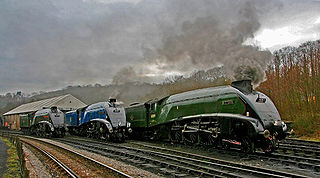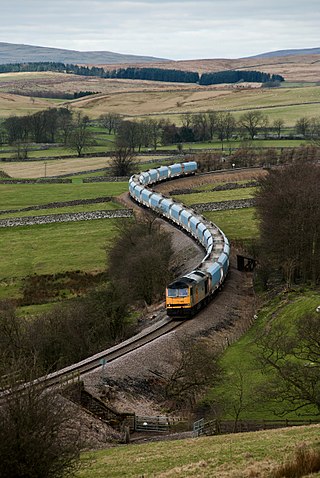
The North Yorkshire Moors Railway (NYMR) is a heritage railway in North Yorkshire, England, that runs through the North York Moors National Park. First opened in 1836 as the Whitby and Pickering Railway, the railway was planned in 1831 by George Stephenson as a means of opening up trade routes inland from the then important seaport of Whitby. The line between Grosmont and Rillington was closed in 1965 and the section between Grosmont and Pickering was reopened in 1973 by the North York Moors Historical Railway Trust Ltd. The preserved line is now a tourist attraction and has been awarded several industry accolades.

The Hull Barnsley & West Riding Junction Railway and Dock Company (HB&WRJR&DCo.) was opened on 20 July 1885. It had a total projected length of 66 miles but never reached Barnsley, stopping a few miles short at Stairfoot. The name was changed to The Hull and Barnsley Railway (H&BR) in 1905. Its Alexandra Dock in Hull opened 16 July 1885.

Mirfield railway station serves the town of Mirfield in West Yorkshire, England. It lies on the Huddersfield Line and is managed by both Northern and Grand Central train operating companies, and is served by TransPennine Express as well. The station is 4 miles (6 km) north east from Huddersfield.

Skipton railway station is a Grade II listed station which serves the town of Skipton in North Yorkshire, England on the Airedale Line, which gives Skipton access to destinations such as Leeds, Bradford, Carlisle, Lancaster and Morecambe. The station is operated by Northern Trains and is situated 27 miles (43 km) north-west of Leeds.

Ferriby railway station serves the village of North Ferriby in the East Riding of Yorkshire, England. The station, and all trains serving it, are operated by Northern. It is situated on the former Hull and Selby Railway, 7+1⁄2 miles (12.1 km) west of Hull Paragon. It has a slightly unusual layout, in that the eastbound platform is located on the main running line but the westbound one is on a loop which continues on towards Brough. The line from Gilberdyke towards Hull through here was quadrupled at the beginning of the 20th century by the NER but reduced to mainly double track again by British Rail in the early 1970s - the section from here westwards though kept the additional running line to allow it to serve a cement works next to the line at Melton Halt, so the westbound platform was left unaltered whereas the opposite one was extended outwards to meet the running line.

Sleights is a railway station on the Esk Valley Line, which runs between Middlesbrough and Whitby via Nunthorpe. The station, situated 2 miles 78 chains (4.8 km) south-west of Whitby, serves the villages of Briggswath and Sleights, Scarborough in North Yorkshire, England. It is owned by Network Rail and managed by Northern Trains.

Dent is a railway station on the Settle and Carlisle Line, which runs between Carlisle and Leeds via Settle. The station, situated 58 miles 29 chains (93.9 km) north-west of Leeds, serves the villages of Cowgill and Dent, South Lakeland in Cumbria, England. It is owned by Network Rail and managed by Northern Trains. It is the highest operational main line station in England.

Apperley Bridge station is situated in Bradford on the line between Leeds and Shipley, West Yorkshire, England. It serves the district of Apperley Bridge in the north-east of the city.

Melton is a village in the civil parish of Welton, East Riding of Yorkshire, England. It is situated about 8 miles (13 km) west of Kingston upon Hull city centre near to the Humber Estuary and about 0.6 miles (1 km) east of the village of Welton, with which it is nearly contiguous.

The Hull and Selby Railway is a railway line between Kingston upon Hull and Selby in the United Kingdom which was authorised by an act of 1836 and opened in 1840. As built the line connected with the Leeds and Selby Railway at Selby, with a Hull terminus adjacent to the Humber Dock.
Boothferry Park Halt railway station opened on 6 January 1951 on an embankment of the former Hull and Barnsley Railway to serve the Boothferry Park football stadium which had opened in Hull, East Riding of Yorkshire in August 1946.

The York–Beverley line was a railway line between York, Market Weighton and Beverley in Yorkshire, England. The line was sanctioned in 1846 and the first part, the York to Market Weighton Line opened in 1847. Construction of the second part to Beverley was delayed for 17 years in part by the downfall of George Hudson, and a less favourable financial environment following the collapse of the 1840s railway bubble; the North Eastern Railway revived and completed the scheme in the 1860s; the Market Weighton to Beverley Line opened in 1865.

The Hull and Hornsea Railway was a branch line which connected the city of Kingston upon Hull with the seaside town of Hornsea in the East Riding of Yorkshire, England.

The Yorkshire Dales Railway was a branch line linking the town of Skipton with the villages of Rylstone, Threshfield and Grassington in North Yorkshire, England. There were two stations on the line - Grassington & Threshfield and Rylstone - and a connection via the Skipton to Ilkley Line to Skipton.

Immingham Dock railway station served the dock at Immingham, Lincolnshire, England.

Kildwick and Crosshills [sic] was a railway station off Station Road in Cross Hills, North Yorkshire, England. It served the villages of Cross Hills, Cowling, Glusburn, Kildwick and Sutton-in-Craven.

Joan Croft Halt railway station was a small halt on the East Coast Main Line (ECML) situated by a level crossing at Joan Croft Junction in South Yorkshire, England. The junction gives access from the ECML to the Skellow line of the West Riding and Grimsby Railway and eventually to Hull, Immingham and Grimsby Docks.

New Holland Pier railway station is a former railway terminus in North Lincolnshire, England. It stood at the seaward end of the New Holland Pier, which juts 1,375 feet (419 m) northwards into the Humber estuary at the village of New Holland. Its purpose was to enable railway passengers, vehicles and goods to transfer to and from ferries plying between New Holland and Hull.
Immingham Halt railway station was a temporary terminus serving people involved in building Immingham Dock, Lincolnshire, England. It was originally named "Immingham Road", but was renamed Immingham Halt when it was upgraded from an unadvertised halt for contractors' workmen to a publicly advertised station in 1910, though it appeared in Bradshaw as plain "Immingham".
Grimsby Pyewipe Road railway station was a temporary terminus serving people involved in building Immingham Dock, Lincolnshire, England.

















